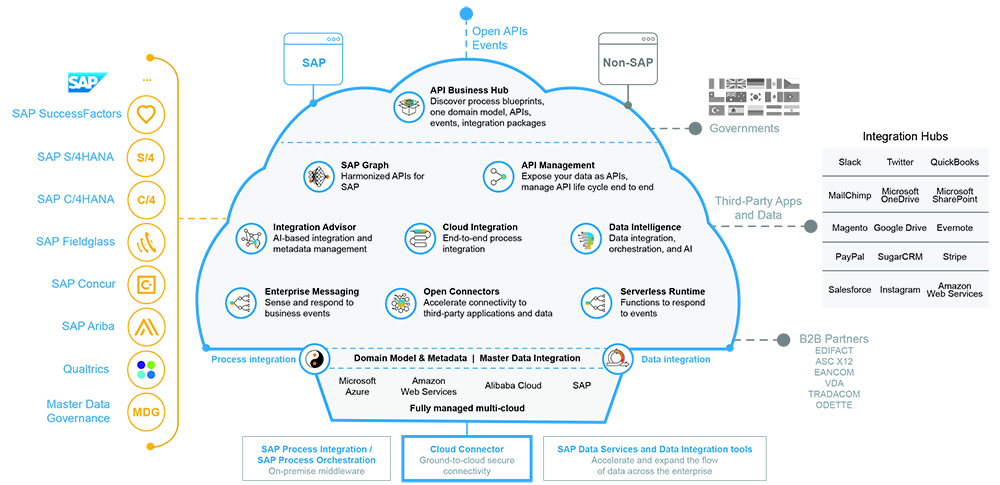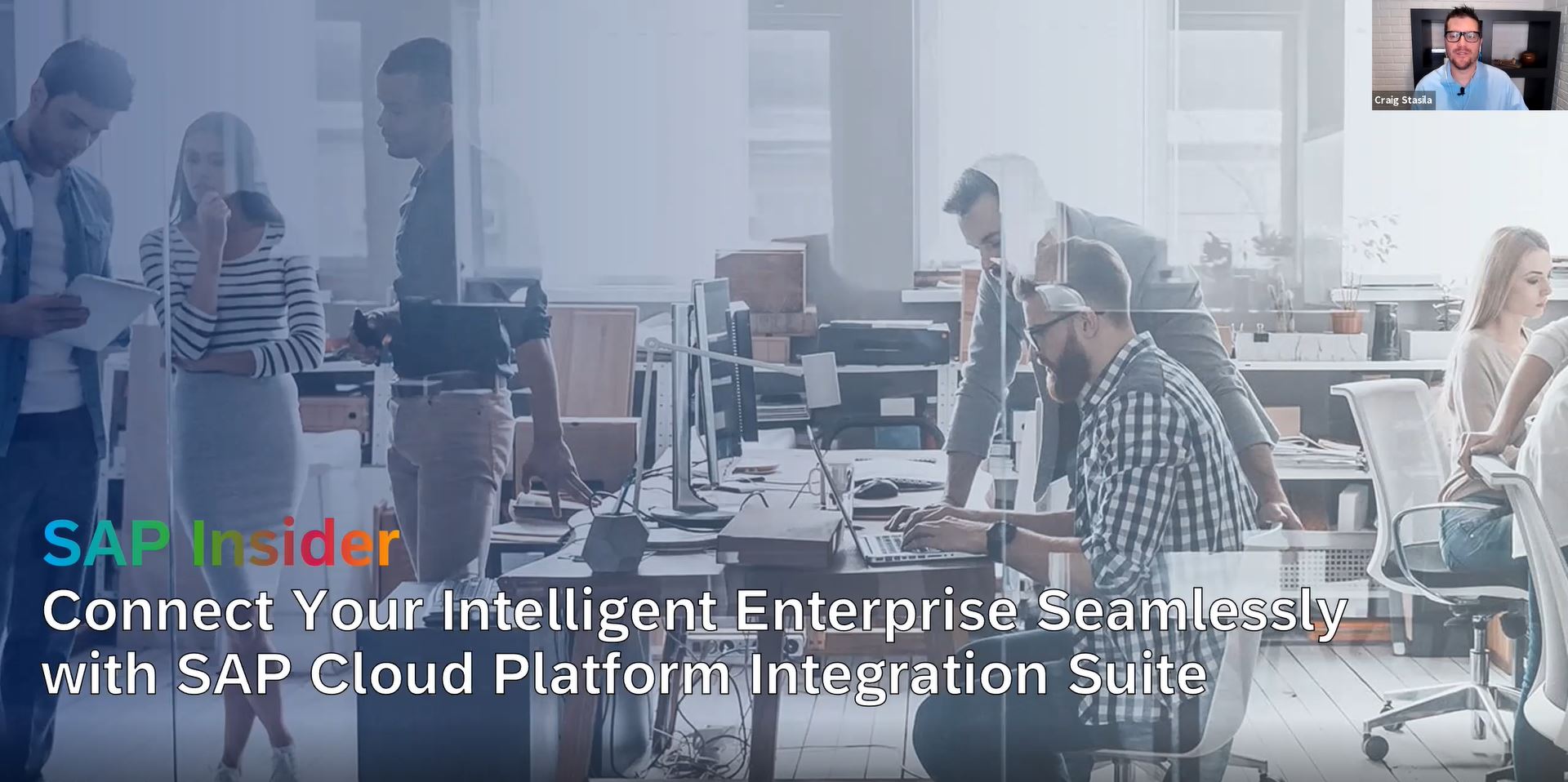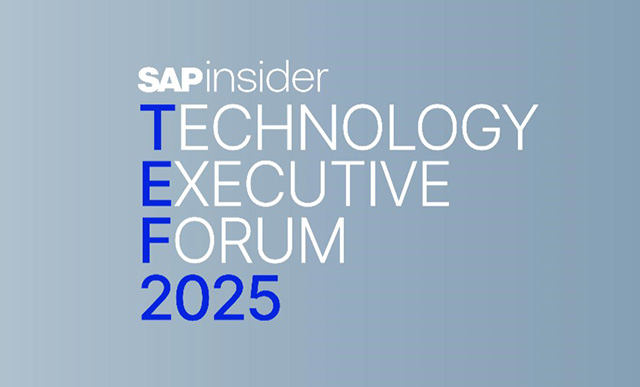Technical Guide: Transitioning to SAP Cloud Platform Integration Suite
Note that this article was published before SAP’s branding changes related to SAP technology announced in January 2021.
by Alexander Bundschuh, Product Manager, Harsh Jegadeesan, VP and Head of Product Management and Strategy for Integration, and Udo Paltzer, Lead Product Manager, SAP
Integration platforms are becoming more strategic for businesses coping with increasingly heterogeneous and hybrid IT landscapes. Seamless integration across applications and systems — whether they are SAP, non-SAP, on-premise, cloud, or hyperscaler systems — enable organizations to digitalize their end-to-end processes and make the enterprise more connected and intelligent. Forward-thinking organizations are taking a holistic and strategic approach to their enterprise integration initiatives as they pursue digital transformation, embracing the agility and simplicity of modern cloud-based integration platforms as they move to more intelligent solutions such as SAP S/4HANA and SAP’s Intelligent Suite.
Explore related questions
The right integration platform can help businesses achieve end-to-end process excellence across their systems, simplify connected experiences for customers, build business-to-business (B2B) networks and digital ecosystems, and innovate with new business models, while also bringing along the best of their existing integration investments. SAP Cloud Platform Integration Suite meets these requirements by enabling holistic and out-of-the-box integrations, including providing support for cloud-to-cloud, ground-to-cloud, and ground-to-ground integration scenarios, as well as emerging integration scenarios involving mobile, Internet of Things, and event-streaming technologies. At the same time, it protects organizations’ existing investments in SAP Process Integration and SAP Process Orchestration integrations.
This article provides guidance for IT architects to help them safely and successfully transition from SAP Process Integration and SAP Process Orchestration to SAP Cloud Platform Integration Suite. It provides an overview of SAP Cloud Platform Integration Suite and then walks through three actions that are key to a successful transition, including upgrading to SAP NetWeaver 7.5 (if an older release is currently running out of maintenance); building new integrations with SAP Cloud Platform Integration Suite; and following best practices for moving existing integration scenarios to SAP Cloud Platform Integration Suite. It also looks at SAP’s roadmap for SAP Process Integration, SAP Process Orchestration, and SAP Cloud Platform Integration Suite to help organizations plan for the journey ahead.
A Hybrid Integration Platform for Modern Environments
SAP Cloud Platform Integration Suite is an open and enterprise-grade integration platform that runs on multi-cloud environments (see Figure 1). It is SAP’s recommended integration platform for simplifying and accelerating integrations for both SAP and third-party integration scenarios. SAP Cloud Platform Integration Suite supports integration in a holistic manner and provides prebuilt integration packages to enable accelerated integrations. It supports a range of integrations, including the integration of applications in the cloud and on premise, master data integration, B2B and electronic data interchange (EDI) integration, business-to-government (B2G) integration, data integration and pipelines, event-driven integration, and integration based on application programming interfaces (APIs). It also supports design and runtime governance of APIs and acts as the foundation for process excellence across the value chain.

Figure 1 SAP Cloud Platform Integration Suite for hybrid and heterogeneous environments
To safely and successfully transition to SAP Cloud Platform Integration Suite while protecting existing investments in SAP Process Integration and SAP Process Orchestration, we recommend the following three actions:
- Upgrade to SAP NetWeaver 7.5. With lower versions reaching end of maintenance at the close of 2020, upgrade to the long-term supported release of SAP NetWeaver, which is 7.5.
- Build new agile integrations with SAP Cloud Platform Integration Suite. Future-proof your hybrid integration strategy by developing new agile integrations — including ground-to-cloud, ground-to-ground, cloud-to-ground, and cloud-to-cloud integrations — using SAP Cloud Platform Integration Suite.
- Move existing integration scenarios to SAP Cloud Platform Integration Suite. Follow best practices to safely and securely move existing integration scenarios to SAP Cloud Platform Integration Suite.
The following sections walk through the details of these recommended actions.
Action 1: Upgrade to SAP NetWeaver 7.5
Many SAP customers already have a well-established on-premise integration scenario based on SAP Process Integration or SAP Process Orchestration, which are SAP’s traditional integration middleware products for on-premise deployments. SAP Process Integration, released in 2002, enables message-based integration between systems in an SAP landscape. SAP Process Orchestration, released in 2011, is a more comprehensive solution that combines SAP Process Integration, SAP Business Process Management, SAP Business Rules Management, and out-of-the-box B2B connectivity support for EDI communications to meet most on-premise integration needs.
Because mainstream maintenance for older releases of SAP Process Orchestration and SAP Process Integration — those based on SAP NetWeaver 7.1x, 7.3x, and 7.4 — will end after 2020 (see SAP note 1648480), we strongly recommend that organizations running those releases first upgrade to SAP NetWeaver 7.5 before moving to SAP Cloud Platform Integration Suite. This way, customers can protect their existing integrations and continue to use their existing integration platform during their SAP S/4HANA migration journey as well.
We recommend that customers migrate existing dual-stack SAP Process Integration deployments to the Java-based single-stack Advanced Adapter Engine Extended (AEX) or to SAP Process Orchestration architectures, depending on the organization’s requirements and license entitlements. With SAP Process Orchestration, customers can address a larger set of use cases — for example, both application-to-application (A2A) and B2B integrations and business process automation for both human- and integration-centric scenarios. In addition, the total cost of ownership (TCO) of the Java-based single-stack installation options provided with SAP Process Orchestration — in terms of hardware, development, operation, and monitoring costs — are 25% to 50% lower compared to the older SAP Process Integration dual-stack architecture. Runtime performance is also significantly higher due to the optimized single-stack architecture, which provides a higher message throughput (approximately twice as high) for asynchronous communication and accelerated response times (approximately 10 times faster) for synchronous communication. For customers that require minimal migration effort, and do not require the benefits of a single-stack architecture, a dual-usage SAP Process Integration architecture is available, but keep in mind that new features will be focused on SAP Process Orchestration.
For organizations looking to take steps toward SAP Cloud Platform Integration Suite, release 7.5 of SAP Process Integration and SAP Process Orchestration provides a built-in cloud integration runtime. This is provided with any SAP Process Integration or SAP Process Orchestration license, and it allows SAP customers to take advantage of the prebuilt integration packages provided with SAP Cloud Platform Integration Suite while deploying the actual integration scenarios on premise. In this case, design-time work is done in the cloud while deployment is through the on-premise runtime. This approach combines the best of both worlds in a hybrid architecture and is readily extensible, as it is based on the Apache Camel standard.
SAP Process Integration and SAP Process Orchestration can be deployed in customer-managed landscapes on premise and in multiple customer-managed cloud environments. SAP Process Orchestration is also available as a managed cloud offering as part of SAP HANA Enterprise Cloud.
Upgrade or Migrate?
When moving to SAP Process Integration, AEX, or SAP Process Orchestration on SAP NetWeaver 7.5 from lower releases, customers can either upgrade or migrate. The decision will depend on criteria such as risk reduction, downtime, and project timelines. An in-place upgrade is usually much faster compared to a migration. However, by performing a migration, the step-by-step process enables better control of the scenarios and provides the ability to roll back if major issues arise in the new environment. In this sense, a migration is a lower-risk approach compared to an upgrade.
When moving from a dual-stack SAP Process Integration system to a single-stack AEX or to SAP Process Orchestration 7.5, migration is the only option, and requires the following steps:
- Install a new AEX or SAP Process Orchestration system running side by side with an already-existing SAP Process Integration dual-stack system.
- Synchronize the System Landscape Directories between the source and the target landscapes.
- Transport the Enterprise Services Repository (ESR) objects from the source to the target landscape.
- Migrate the integration directory objects using the built-in directory content migration tool.
- Redesign ABAP-based artifacts — such as ABAP mappings and cross-component Business Process Management (ccBPM) processes — in the target system.
- If a third-party solution is used for B2B and EDI integration, migrate that solution to the SAP Process Integration B2B add-on and configure the necessary settings — for example, set up partner profiles and agreements in the trading partner management system, convert the mappings, and reconfigure the adapters.
- Perform operational tasks, such as setting up new message-based alerting.
- Use the SAP Process Integration test tool to run automated integration tests to reduce downtime.
- Phase out the SAP Process Integration dual-stack system once all the integration scenarios are live on the target landscape.
Note that with support package 14 for release 7.5 of SAP NetWeaver, SAP provides a process integration test (PIT) tool that can be used to set up and run automated integration scenario tests, including automated regression tests and post-migration tests.
Action 2: Build New Agile Integrations with SAP Cloud Platform Integration Suite
If you haven’t already done so, start using SAP Cloud Platform Integration Suite for running cloud and hybrid integration scenarios. SAP Cloud Platform Integration Suite is a cloud-based integration platform that connects and contextualizes processes and data while enabling new content-rich applications to be assembled rapidly and with less dependence on IT teams. It offers a way to deploy integration flows to any cloud infrastructure provider as well as to SAP Process Orchestration, and it provides an easy-to-use and flexible cloud environment to design, deploy, and monitor hybrid integration scenarios.
With SAP Cloud Platform Integration Suite, customers can leverage prebuilt integration packages from SAP and partners to get rich, out-of-the-box integrations for SAP-to-SAP and SAP-to-non-SAP integration scenarios up and running quickly. These integration packages, available at SAP API Business Hub, simplify and accelerate integrations between business applications with predefined semantic field-level mappings, integration flows, and documentation in packages that can be configured and deployed in the customer’s SAP Cloud Platform Integration Suite tenants. SAP provides full support and updates to the packages, which reduces the effort required when application interfaces change. Customers can also build new integrations using SAP Cloud Platform Integration Suite for cloud-to-cloud, ground-to-cloud, and even ground-to-ground integrations. SAP supports hybrid deployment by embedding the cloud integration runtime in SAP Process Orchestration and SAP Process Integration 7.5 and enabling deployment of new ground-to-ground integration scenarios on premise.
SAP Cloud Platform Integration Suite supports a holistic set of integration approaches, including process integration (that is, A2A and B2B integration); data integration; open API-based integrations; and event-based, extensible integrations. It provides full-featured API management capabilities — ensuring enhanced support for API-based digital business services — that support digital transformations and help organizations extract value from data lakes. SAP Cloud Platform Integration Suite also supports non-SAP-to-non-SAP integration scenarios through a set of non-SAP adapters and rich design-time tools, which provide for a low- or no-code integration approach.
The capabilities included with SAP Cloud Platform Integration Suite help organizations simplify and accelerate their integrations, including access to 1,400+ prebuilt integrations; support for fully managed multi-cloud deployments; deep native integration with SAP solutions; and a foundation based on open standards, including 1,200+ open APIs and 160+ open connectors to third-party applications. Extending SAP Cloud Platform Integration Suite with additional SAP technologies provides further value for SAP customers — for example, by enabling the use of SAP HANA to deliver high-performance and secure API-based digital business services, such as SAP Data Intelligence to gather and deliver streamed data and unstructured data and the Common Data Model to ensure that enterprise applications have common meanings and formats for data.
More detailed information on building new integrations is available at the SAP Cloud Platform Integration Suite product page.
Action 3: Move Existing Integration Scenarios to SAP Cloud Platform Integration Suite
As part of a broad cloud strategy, or as part of a digital transformation to SAP S/4HANA and SAP’s Intelligent Suite, organizations should move their integration scenarios to a deployment model that is either cloud-based or a hybrid (with design time in the cloud and runtime in the cloud or on premise). This will allow them to take advantage of cloud qualities such as lower operational costs, choice of deployment, flexible configuration options, and regular platform updates. SAP Cloud Platform Integration Suite supports all integration scenarios, including cloud-to-cloud, ground-to-cloud, cloud-to-ground, and ground-to-ground integrations. In addition, there are best practices organizations can follow when moving existing on-premise integration scenarios to SAP Cloud Platform Integration Suite to ensure a successful transition.
Move All Cloud and Hybrid Integration Scenarios to SAP Cloud Platform Integration Suite
When migrating from a dual-stack SAP Process Integration system to SAP Process Orchestration, customers should move all cloud (cloud-to-cloud) and hybrid (ground-to-cloud) integration scenarios by default to SAP Cloud Platform Integration Suite. Customers can connect SAP Cloud Platform Integration Suite to the ESR of the SAP Process Integration or SAP Process Orchestration system and import the mappings and service interfaces. This way, customers can reuse existing interfaces and mappings when moving scenarios from SAP Process Orchestration to SAP Cloud Platform Integration Suite.
Use API Management for Pass-Through Integration Scenarios
Organizations often use a decentralized adapter engine in the demilitarized zone (DMZ) for pure pass-through integration scenarios. This is a common setup to control authentication and secure the message flow going into the network. When reviewing the integration architecture, consider moving pass-through integration scenarios to API Management within SAP Cloud Platform Integration Suite and then applying API security best practices, traffic policies, and access controls to your APIs. API Management provides a solution for the full lifecycle management of APIs. It complements SAP Cloud Platform Integration Suite and SAP Process Orchestration by providing the full lifecycle management of APIs, from design, development, management, and usage analytics to engaging with the developer community.
Use the Cloud Integration Runtime for Hybrid Deployments
With SAP NetWeaver 7.5, SAP provides two messaging runtime engines: a process integration messaging runtime and a new cloud integration runtime. The process integration messaging runtime is mainly used for stateless message processing, and integration scenarios running on this runtime are fully designed and configured on SAP Process Integration or SAP Process Orchestration. The cloud integration runtime on the other side supports the integration flows developed on SAP Cloud Platform Integration Suite. Modeling of the integration flows is done on an SAP Cloud Platform Integration Suite tenant while the deployment can be realized either in the cloud (for cloud-to-cloud and ground-to-cloud scenarios) or on premise (for ground-to-ground scenarios).
The cloud integration runtime is a modern runtime that supports a flexible pipeline. The flexible modeling and runtime capabilities of this runtime support complex integration scenarios based on well-established enterprise integration patterns. For example, service and API composition scenarios are easy to build with the flexible pipeline in the cloud integration runtime compared to the more static pipeline in the process integration messaging runtime, because its runtime allows orchestration of the message flow with pure low-code modeling without the need for custom code. It also supports stateful integration patterns, including aggregation, composed message processor, and scatter-gather patterns.
If an organization has existing service and API composition scenarios or integration-centric scenarios modeled with ccBPM in a dual-stack SAP Process Integration system, we recommend that it migrate these to SAP Cloud Platform Integration Suite. For new, agile integrations, be sure to follow best practices while building integration packages and integration flows. These best practices include recommendations for designing and building enterprise-grade integration flows in a robust fashion, and implementing commonly used enterprise integration patterns such as content-based routing, content enricher, splitter, aggregator, and scatter-gather patterns.
The Path Ahead
So, what’s next for SAP’s integration solutions? Here, we summarize SAP’s current plans for SAP Process Integration and SAP Process Orchestration implementations, and for SAP Cloud Platform Integration Suite (further details are available in SAP’s online roadmaps).
Existing SAP Process Integration and SAP Process Orchestration Implementations
With the extension of maintenance for SAP NetWeaver Java 7.5, customer investments in SAP Process Orchestration and its components are secure and supported until at least 2030. Existing SAP customers will continue to benefit from new cloud integration runtime capabilities that were enabled with SAP Process Orchestration 7.5.
SAP Cloud Platform Integration Suite
SAP Cloud Platform Integration Suite with support for multi-cloud and hybrid deployment is the hybrid integration platform of choice for SAP customers. SAP Cloud Platform Integration Suite is available as a fully SAP-managed multi-cloud offering that can run on Amazon Web Services, Microsoft Azure, Alibaba Cloud, and SAP National Security Services (SAP NS2) for FedRAMP customers, in addition to SAP’s data centers. Customers adopting a hyperscale infrastructure provider strategy can leverage SAP Cloud Platform Integration Suite in the public cloud of their choice.
For customers that still require deployment support in on-premise or private cloud environments, SAP will offer a hybrid deployment of SAP Cloud Platform Integration Suite with the ability to deploy independent of the full SAP NetWeaver stack. The design, configuration, and monitoring will be in the cloud — that is, on a customer’s SAP Cloud Platform account — while the runtime, known as the “integration cell,” will leverage container technology such as Docker, and can be deployed and managed by customers. An integration cell can host the customer’s required SAP Cloud Platform Integration Suite services and engines, such as SAP Cloud Platform Integration Suite worker nodes for process integration, an API gateway for enforcing security and traffic policies, an enterprise messaging system for event-driven integration, and a cloud connector for securing the cloud-to-ground integrations.
This type of hybrid deployment provides additional flexibility on top of the fully managed multi-cloud SAP Cloud Platform Integration Suite offering, and availability is planned for 2021. For select regulated markets, SAP also plans to support a private cloud offering that can be completely deployed in a private, on-premise environment. To help with monitoring and operating these types of hybrid, complex integration architectures, SAP offers application lifecycle management (ALM) solutions such as SAP Focused Run for SAP Solution Manager and SAP Cloud ALM, which provide an end-to-end view of message exchanges and alerts when exceptions occur.
For organizations that have already started using the cloud integration runtime inside SAP Process Orchestration, transitioning those integration scenarios to the new hybrid deployment architecture can be easily done with minimal effort. In addition, integration content built in SAP Process Orchestration, such as mappings and service interfaces, can be easily imported from ESR to SAP Cloud Platform Integration Suite. In the roadmap for SAP Cloud Platform Integration Suite, SAP will provide a self-service migration tool to migrate integration scenarios from SAP Process Orchestration to SAP Cloud Platform Integration Suite as customers move to the hybrid integration platform.
Summary
Many existing SAP customers have significant investments in SAP Process Integration and SAP Process Orchestration to support their enterprise integration scenarios. To protect these investments, SAP will continue to support these solutions and help provide a seamless and safe transition to SAP Cloud Platform Integration Suite, which is SAP’s recommended technology for simplifying and accelerating integration in both SAP and third-party integration scenarios. SAP is providing this support by extending mainstream maintenance for SAP NetWeaver 7.5 until the end of 2027, as well as offering extended maintenance until the end of 2030. In addition, SAP is allowing customers to convert some old on-premise SAP Process Integration and SAP Process Orchestration licenses to cloud licenses to support the move to the cloud (ask your account executive about the cloud extension license conversion program).
SAP Cloud Platform Integration Suite is a valuable tool for solving modern integration problems in the areas of lead to cash, recruit to retire, source to pay, design to operate, and digital compliance, for instance. By taking the three actions outlined in this article — protect existing integration scenarios by migrating them to SAP NetWeaver 7.5, build new integrations with SAP Cloud Platform Integration Suite, and safely move old integration scenarios to SAP Cloud Platform Integration Suite — SAP customers can ensure that their integrations successfully support their current and future needs.
Learn more about using SAP Cloud Platform Integration Suite to support integrations in the online course Simplify Integration with SAP Cloud Platform Integration Suite, which is available free of charge via the openSAP educational platform until June 30, 2020.

Dr. Alexander Bundschuh (alexander.bundschuh@sap.com) is part of the Product Management team for Integration at SAP. He has been with SAP for almost 20 years in different roles. As a Product Manager, Alex mainly supports SAP Process Orchestration, SAP Cloud Platform Integration, and SAP Application Interface Framework.

Dr. Harsh Jegadeesan (harshavardhan.jegadeesan@sap.com) is VP and Head of Product Management and Strategy for Integration at SAP. He helps customers craft and execute their API and Integration strategies in their journey toward an Intelligent Enterprise. Harsh has broad experience in enterprise applications, platforms, data, and process management solutions. Harsh holds a PhD in Computer Science.

Dr. Udo Paltzer (udo.paltzer@sap.com) is a Product Manager for SAP’s integration platform technology, with a focus on process integration and API-based integration. He has 20 years of experience in the area of integration, including experience with cloud and on-premise integration technology. As a Product Manager, Udo supports customers in their cloud integration journey.








